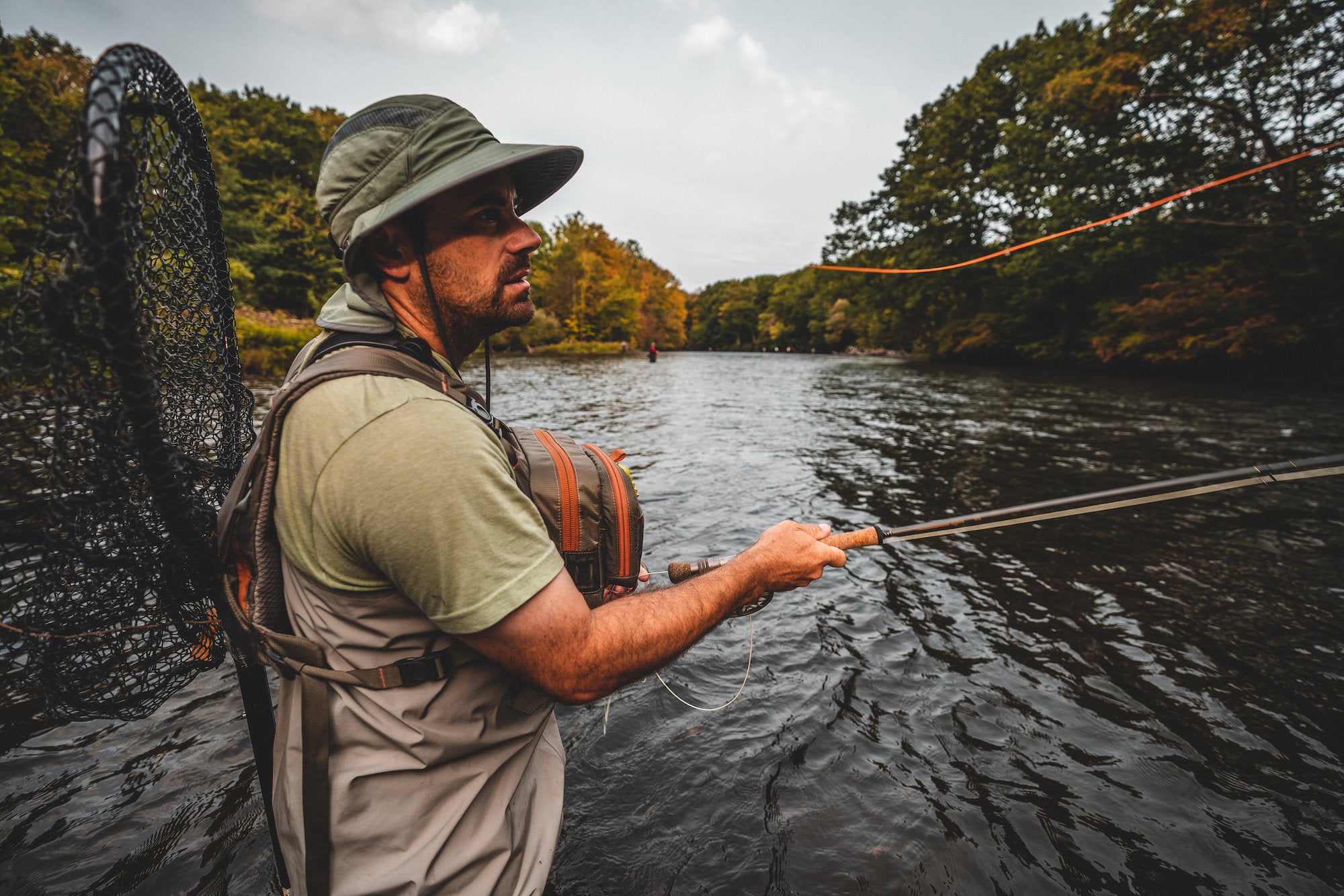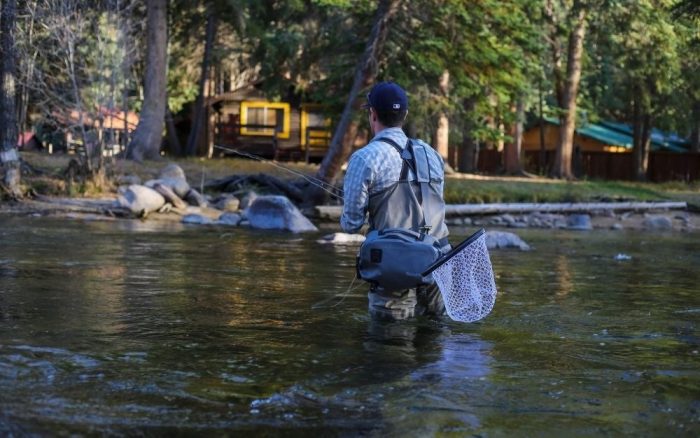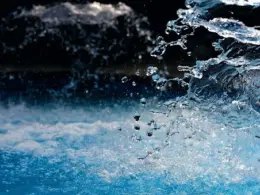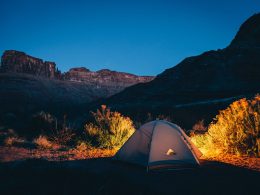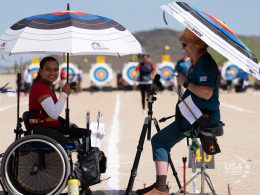It’s hot, it’s humid and there’s bugs everywhere, so it’s probably a good time to set the poles down and wait for the beginning of fall before you hit the water again. If you do so, then you’d be missing out a great opportunity to get out and catch some fish.
Just because it’s hot and the bass move deeper doesn’t mean you still can’t go out with a fly rod and pull in some largemouth or smallmouth bass. Fish need to eat no matter the weather and we’re going to show you how to catch them in both lakes and rivers.
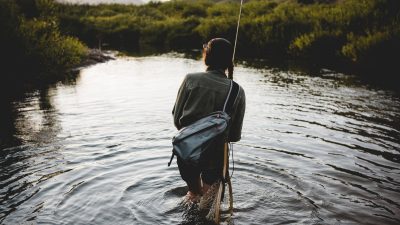
Table of Contents
Rivers
During this time of the year, you’ll want to focus on the larger rivers. Smaller rivers can produce but after the early morning the water can really warm up and can turn off the bite. If you don’t have a choice, then find larger pools and pockets in these small bodies of water and fish them deep. That’s where the fish will be holding in during the warm days of the year. Also, hitting up those smaller rivers early in morning or later in the evening can produce bites as well.
Now that you’ve picked out your river head over to your state DNR website and look for areas to float. Most likely they’ll have a list of boat ramps and how far away they are from each other. From here you can pick out whether you want to do a full day float (6-10 miles) or a half day (3-5 miles). Of course, the duration of the float all depends on the flow of the river and how many breaks you plan on taking.
After that you’ll need to figure out how you’re going to shuttle. If you’re planning on floating down stream to the next ramp, then you’ll need someone to either drop off your car or someone will need to be there to pick you up. Some folks who don’t want to pay for a shuttle company or don’t have someone to shuttle them can drop off a bike or something else at the ramp and then ride that back to their car where they can drive back down and load up their boat.
If none of those options are possible then you either wade or bank fish, or paddle upstream and float your way down. If you plan on wading, then you need to ensure the river is shallow enough to do so. Often your local fly shop or the DNR website will let you know.
If you’re going to paddle against the current and then float back down, then you need to ensure your dressed properly and have enough water. This is much more difficult than just floating with the current to the drop-off.
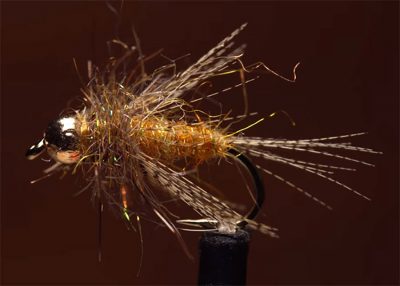
Lakes
Lake fishing for bass in the Sumer is like river fishing but with a few adjustments. First, you’ll want to be able to have electronics on your boat. Knowing whether you’re near a drop off and how deep the water you’re fishing plays an important role in locating fish.
Also, electronics will help you find underwater structure that you might not be able to see. Rivers are normally much shallower, and you can spot boulders and stumps. This is not always the case in lakes where you might be fishing in 20’ of water.
If you’re bank fishing or don’t have electronics, then you’re limited to what you can see. Casting to docks, or other shadowy spots are great areas to focus on. You can also find fallen trees on the banks and lily pads. All of these are shaded areas that bass will hang out and look to ambush their prey.
Earlier we touched on sinking and floating lines. While you can get away with using a floating line all day for lake fishing, having a sink tip is much more important. There are whole areas of the lake where you may need to get down deep and if you have a floating line then it’s just not possible to do so.
A full sinking line can be great as well. Sometimes bass want something on the bottom and slowly working a crawfish along the edges of submerged grass can be a great way to catch them. This isn’t possible with a floating line and sometimes not even a sink tip.
If you don’t have a boat or a kayak then your limited to the shore, however that’s not always a bad thing. Find docks, fallen trees, overhanging limbs or anything that throws a shadow. Spend the day beating up shady spots on the bank and you’re sure to pull some out.
Now that the preliminary planning is done it’s time to talk gear.
Rods
For bass fishing you’ll want to use a 9’ rod in the 6-8 weight range. This allows you to throw the size of flies needed to entice bass and gives you some backbone when you land into a nice one.
Reel
Ensure your reel is the same weight as your rod, in the 6-8 range. You don’t need an expensive reel for bass fishing since most of the time you’ll be pulling in line with your hand. Just a reel that holds enough line for you to cast and a decent drag system is all you need.
Line
Floating line can be used all day when river fishing. A topwater bug or a streamer that runs high in the water column is usually good enough to catch fish no matter what the water temperature is like. However, if you have a sink tip line then that is going to help once the morning ends and the sun starts to heat up the water quickly.
If you find yourself approaching deep pools and those first few hours of the morning are over then throwing a streamer and allowing it to sink a little into the water will increase your hookups.
Flies
If you live East of the Mississippi river then there’s a good chance you’ve got cicadas. Having a few flies that mimic these loud bugs can be a great way to start the morning and can even catch them during the middle of the day.
Poppers, wooly buggers, clousers, crawfish and any other streamer are a must have in your fly box. Tie on the one you have the most confidence with and then see how the fish like it. They may want a popper in the morning and then a crawfish at mid-day. If you’re not getting bites then keep trying new flies to see what they like.
When throwing poppers or other topwater flies it’s best to have them land as loud as possible then let them sit until the wake of the fly dissipates. If you’re not having any luck with dead drifting your fly, then allow it to land and wait a few seconds before popping it or stripping in line to let it skirt across the top of the water. Keep shortening the time it sits after it lands until you find what the fish like.
The opposite is true with streamers. I like to start stripping it in the moment it hits the water. The only time I’ll wait is if I want it to sink a little bit deeper in the water column.
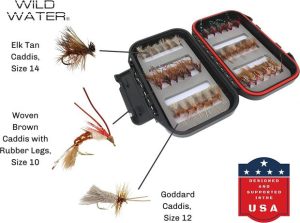
Structure
The moment you hit the water you need to start trying to figure out where the bass are located. Start looking for structure in the water. Sunken trees, lily pads, boulders, a sunken boat, drop offs. Anything that stands out to you will stand out to the fish.
If the flow of the river is nice and slow then really break down those pieces of structure from multiple angles. If it’s fast you might only get one cast at that boulder or log.
Avoiding the Crowds
It happens every year. The weather gets hot and jet skiers, boater, and river floaters storm the water. The best thing you can do is ether hit the water early or find spots where they’re not. Hitting the water is the easiest and best way to go about it, but if you can’t avoid the crowds then sit back and watch where everyone goes. Often there will be plenty of coves on lakes that only anglers will be using.
People floating rivers in tubes are harder to ignore. You can find areas where large companies drop off and pick up tubers and then avoid those areas. Otherwise, you’re better off just getting there before they even start.
Apparel and Extras
Sun shirts, hats, sunglasses, lightweight pants or shorts and sunscreen are all needed for a day on the river in the middle of summer. There’s a good chance you will be without shade for the whole day, and you’ll also be out when the UV index will be at its peak. Not protecting yourself from the sun can really put a damper on the day and if you’re anything like me then a bad sunburn can ruin a full week. Dress appropriately and not only will you stay cooler out on the water, but you’ll also prevent a sunburn.
Bring enough water. The amount you bring will need to depend on the temperature. Once the heat index is over 90 or over 100 then you need to make sure you have enough for the day. A lack of water could lead to heat stroke or dehydration and that’s one way end a trip early. At eight pounds a gallon water is heavy but it’s not something to skimp on. Overpack and hope you don’t need to drink all of it.
A meal or some snacks can be a great way to break up the day and to give yourself a little rest. Find a nice shady spot and have a sandwich or some chips and allow yourself to cool down in the middle of the day. Hop in the water after and go for a dip if the heat is even more egregious.
Final Thoughts
Fishing in the middle of summer can be intimidating. The heat is oppressive and there are more people partaking in watersports than ever before, leaving lakes and rivers crowded.
However, the fish aren’t going anywhere. As the old saying goes, “proper preparation prevents piss poor performance.”

